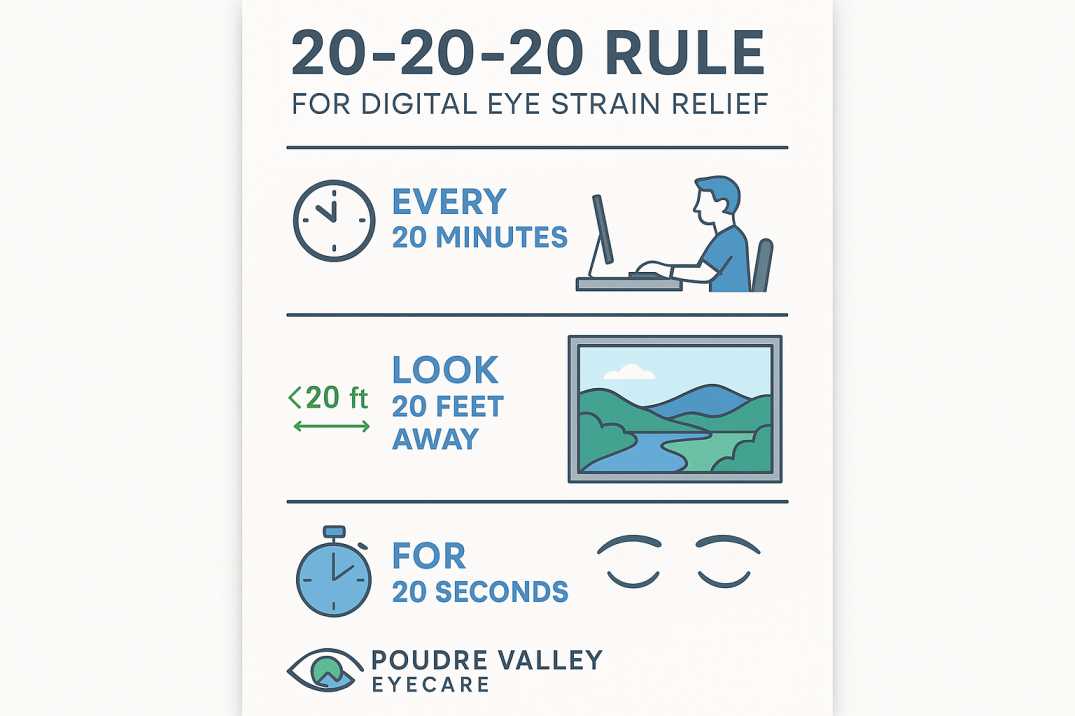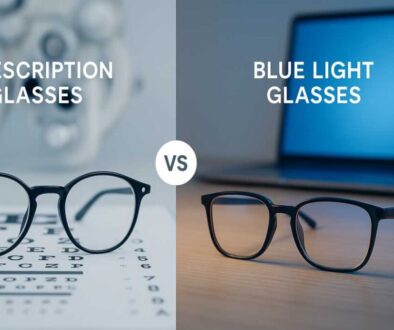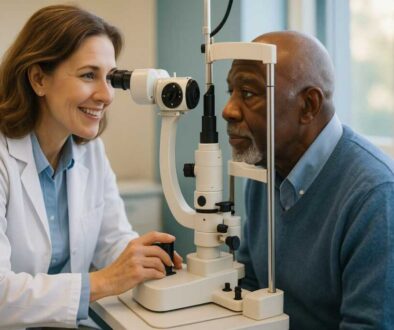Computer Vision Syndrome Solutions | Fort Collins Eye Doctor
Understanding Digital Eye Strain: Fort Collins’ Growing Challenge
Digital eye strain (also called computer vision syndrome) affects two out of every three Fort Collins residents who spend significant time on screens. With our city’s booming tech industry—from Broadcom software engineers earning $150K+ to Hewlett-Packard Enterprise cloud specialists—screen time has become unavoidable. The result? An epidemic of tired, burning eyes that threatens both productivity and quality of life.
What Makes Digital Eye Strain Different?
Unlike reading printed text, viewing digital screens forces your eyes to work significantly harder. Computer screens present unique visual challenges: pixelated characters lack sharp edges, reduced contrast between text and background strains focusing muscles, glare and reflections create additional visual obstacles, and constant refocusing between different screen elements exhausts eye muscles.
The Fort Collins Context: Research shows our local tech workers spend an average of 7-10 hours daily on digital devices—significantly higher than the national average of 6 hours. This extended exposure, combined with Colorado’s high-altitude bright sunlight, creates additional glare, intensifies symptoms for Northern Colorado residents.
Key Takeaways
- 66% of Americans experience digital eye strain symptoms, making it the #1 occupational hazard for knowledge workers
- Fort Collins tech professionals face a higher risk due to the city’s thriving tech sector and extended screen time
- The 20-20-20 rule reduces symptoms by 70%: Every 20 minutes, look 20 feet away for 20 seconds
- Computer-specific prescription glasses can drastically reduce strain, even for those with perfect distance vision
- Comprehensive eye exams identify underlying issues – schedule annually with Medicare/Medicaid-accepting providers
- Environmental modifications matter: proper screen positioning, lighting, and ergonomics prevent long-term damage
- Recent 2024-2025 research confirms that blue light filters don’t reduce eye strain – focus on breaks and positioning instead
The Science Behind Screen-Related Eye Fatigue
How Your Eyes Process Digital Content
Recent comprehensive literature reviews analyzing data from 103 cross-sectional studies with 66,577 participants determined that approximately 66% of people experience computer vision syndrome symptoms, making it a major public health concern.
Three primary mechanisms cause digital eye strain:
1. Accommodative Mechanism (Focusing System) Your ciliary muscles constantly adjust to maintain sharp focus on screen text. This continuous micro-adjustment creates fatigue, especially at intermediate distances (20-28 inches) where most computer work occurs.
2. Extraocular Mechanism (Eye Movement) Beyond the eye itself, prolonged screen use causes musculoskeletal symptoms, including neck stiffness, shoulder pain, and headaches. These result from improper screen positioning and poor ergonomic setup.
3. Ocular Surface Mechanism (Dry Eye) Studies show that screen users blink only 3-7 times per minute compared to the normal rate of 18-22 blinks per minute. This dramatic reduction in blinking leads to tear film evaporation, causing dry, irritated eyes.
Recognizing the Symptoms: Are You Experiencing Digital Eye Strain?
Common Warning Signs
Digital eye strain manifests through various symptoms that typically worsen throughout the workday:
Visual Symptoms:
- Blurred vision (especially when switching between screen and distance viewing)
- Double vision or diplopia
- Difficulty refocusing
- Eye fatigue and heaviness
- Burning or stinging sensations
- Dry, irritated eyes
- Redness and inflammation
- Foreign body sensation (feeling like something’s in your eye)
- Excessive tearing (paradoxical response to dryness)
- Sensitivity to light
Systemic Symptoms:
- Headaches (frontal or behind the eyes)
- Neck and shoulder pain
- Back discomfort
- General fatigue
- Reduced productivity and concentration
Fort Collins-Specific Risk Factors: Local professionals in software development, graphic design, and healthcare administration face elevated risk due to both high screen time and the precision visual demands of their work.
The Fort Collins Digital Landscape: Why Local Professionals Are at Higher Risk
Our City’s Tech-Heavy Economy
Fort Collins’ technology sector has experienced remarkable growth, with major employers including Broadcom, Hewlett-Packard Enterprise, and Woodward Inc., and a projected 15% increase in tech job growth by 2025. This economic boom brings increased screen exposure across demographics.
High-Risk Occupations in Fort Collins:
- Software engineers and developers (8-12 hours daily screen time)
- Graphic designers and digital artists (intensive visual precision work)
- Healthcare workers using electronic medical records
- Educators managing online platforms
- Financial services professionals
- Remote workers and hybrid employees
The COVID-19 Impact
Digital eye strain prevalence surged from 5-65% in pre-COVID studies to 80-94% during the pandemic era, with Fort Collins residents experiencing similar trends as remote work became standard. Many professionals continue hybrid schedules, maintaining elevated screen exposure levels.
Evidence-Based Solutions: What Actually Works
The 20-20-20 Rule: Your First Line of Defense
Studies have shown that teaching the 20-20-20 technique to people with computer vision syndrome helps ease their dry eye symptoms. This simple practice—looking at something 20 feet away for 20 seconds every 20 minutes—allows your eye muscles to relax and reset.
How to Implement in Fort Collins Offices:
- Set recurring phone reminders
- Use apps like Time Out or EyeCare
- Look out the windows at the nearby foothills (natural 20+ foot distance)
- Combine with brief standing or stretching breaks
- Practice during video calls by focusing on distant objects
Optimize Your Workspace Ergonomics
Screen Positioning Guidelines:
- Distance: 20-28 inches from your eyes (arm’s length)
- Height: Top of screen at or slightly below eye level
- Angle: Tilt the top of the screen back 10-20 degrees
- Reduce glare: Position perpendicular to windows
Fort Collins Lighting Considerations: Our abundant Colorado sunshine creates unique challenges. Use blinds or curtains to control natural light, position your desk to avoid direct window glare, choose matte-finish screens over glossy displays, and use indirect lighting rather than overhead fluorescents.
Computer-Specific Eyewear: A Game-Changer
In some cases, individuals who do not require glasses for other daily activities may benefit from glasses prescribed specifically for computer use, similar to how some people use glasses for driving at night.
What Makes Computer Glasses Different?
- Optimized for intermediate distance (20-28 inches)
- Anti-reflective coating reduces glare
- Precise power adjustment for screen viewing
- May include slight magnification even with perfect distance vision
Important 2024-2025 Research Finding: Low-certainty evidence from multiple randomized controlled trials found that blue-light filtering glasses do not reduce eyestrain in computer users. Focus instead on proper prescription correction and workspace setup.
Professional Eye Care: The Poudre Valley Eyecare Approach
Comprehensive Digital Eye Strain Assessment
As Fort Collins’ trusted eye care provider for over 25 years, Poudre Valley Eyecare understands the unique challenges facing our local tech community. Our comprehensive approach includes:
Specialized Computer Vision Exam Components:
- Measurement of your exact working distance
- Assessment of intermediate vision needs
- Evaluation of convergence and accommodation
- Tear film stability testing for dry eye
- Screen of binocular vision function
- Discussion of your specific work environment
When to Schedule an Appointment
See an eye doctor if you experience:
- Symptoms persisting despite implementing the 20-20-20 rule
- Progressive worsening of vision
- Persistent headaches affecting work performance
- Symptoms interfering with daily activities
- No eye exam within the past 12 months
Poudre Valley Eyecare Accessibility: We accept both Medicare and Medicaid, making quality eye care accessible to all Fort Collins residents regardless of insurance status. Our convenient South College Avenue location sits just minutes from Colorado State University and major tech employer campuses.
Advanced Treatment Options for Persistent Symptoms
Prescription Solutions
Artificial Tears and Lubricants Over-the-counter preservative-free artificial tears provide immediate relief for dry eye symptoms. Studies show that oral omega-3 supplementation for 45 days to 3 months improved dry eye symptoms in computer users, providing a complementary approach to topical treatments.
Prescription Eye Drops. For chronic dry eye, prescription medications like cyclosporine or lifitegrast may be necessary. These anti-inflammatory drops address the root cause rather than just symptoms.
Vision Therapy for Complex Cases
Some patients experience focusing or eye coordination problems that glasses alone cannot correct. Vision therapy—a structured program of visual activities—trains your eyes and brain to work together more effectively, addressing deficiencies in eye movement, focusing, and eye teaming.
Specialized Lens Technologies
Progressive Addition Lenses for Computer Work. Unlike traditional progressives, computer-specific progressives optimize the intermediate and near zones while minimizing the distance portion you don’t need at a desk.
Anti-Fatigue Lenses: These incorporate a small amount of accommodative support in the lower portion, reducing the work your eye muscles perform during sustained near tasks.
Lifestyle Modifications: Building Long-Term Eye Health
Daily Habits That Make a Difference
Hydration and Nutrition Proper hydration supports tear production. Aim for 8-10 glasses of water daily, especially in Fort Collins’ dry climate. Omega-3 fatty acids from fish oil or flaxseed support tear film quality and reduce inflammation.
Environmental Control
- Use a humidifier in dry office environments (especially important in Colorado)
- Position the air vents away from your face
- Take walking breaks outdoors to reset accommodation
- Practice good sleep hygiene to reduce eye fatigue
Screen Hygiene
- Clean your screen weekly to reduce strain from dust and smudges
- Adjust brightness to match ambient lighting
- Increase text size to a comfortable reading level
- Use dark mode in low-light conditions
- Enable blue light filters in the evening (for sleep quality, not eye strain)
Exercise and Outdoor Time
Recent research links increased outdoor time with reduced myopia progression, particularly important for Fort Collins families with children. Take advantage of our city’s excellent trail system—the Cache la Poudre River Trail and Fossil Creek Trail offer perfect opportunities for screen-free breaks that benefit eye health.
The Mental Health Connection: Why Eye Strain Matters Beyond Vision
The Productivity-Wellbeing Link
Studies show a direct link between digital eye strain and increased stress, anxiety, and reduced productivity. When your eyes struggle to focus, your brain works harder, triggering fatigue that amplifies irritability and difficulty concentrating.
The Sleep Disruption Cycle Blue light emitted by screens suppresses melatonin production, disrupting sleep patterns. Poor sleep exacerbates eye strain, creating a vicious cycle. A 2022 Harvard Medical School study found that participants exposed to blue light before bed took 30% longer to fall asleep.
Fort Collins Solutions:
- Practice screen-free evenings 1-2 hours before bed
- Use apps like Headspace or Calm for 5-minute break meditations
- Take advantage of local wellness resources
- Prioritize work-life balance to reduce overall stress
Prevention Strategies for Fort Collins Professionals
Industry-Specific Recommendations
For Software Engineers and Developers:
- Use high-contrast coding themes (not just dark mode)
- Increase font size to reduce squinting
- Position multiple monitors at consistent distances
- Take breaks between intense debugging sessions
- Consider using an IDE with customizable color schemes
For Graphic Designers:
- Calibrate monitors regularly for color accuracy
- Use anti-glare screen filters
- Alternate between detailed work and broader tasks
- Position reference materials at the same distance as screens
- Schedule eye exams specifically addressing color perception
For Healthcare Workers:
- Position EMR screens at ergonomic heights
- Use dictation software to reduce typing/screen time
- Implement batch charting rather than constant documentation
- Advocate for proper office lighting in clinical settings
For Remote and Hybrid Workers:
- Invest in a proper home office setup
- Separate work and personal device use when possible
- Use external monitors rather than laptop screens
- Create a dedicated workspace with good lighting
- Set boundaries for after-hours screen time
Children and Digital Eye Strain: What Fort Collins Parents Need to Know
The Rising Concern in Young Populations
Digital eye strain prevalence amongst children alone rose to 50-60% in the COVID-19 era, with symptoms expanding to include recent onset esotropia and vergence abnormalities. Fort Collins parents must be vigilant as online learning continues.
Warning Signs in Children
- Frequent eye rubbing
- Complaints of headaches
- Sitting very close to screens
- Covering one eye when viewing devices
- Difficulty reading or declining academic performance
- Avoiding screen-based homework
Protective Measures for Families
The 20-20-20 Rule for Kids: Make it a game—have children identify objects 20 feet away during breaks. Use timers with fun sounds to remind them.
Screen Time Recommendations:
- Ages 2-5: Limit to 1 hour daily of high-quality programming
- Ages 6+: Establish consistent limits based on individual needs
- Encourage outdoor play (Fort Collins offers excellent parks and trails)
- Create screen-free zones (bedrooms, dinner table)
- Model healthy screen habits as parents
Annual Eye Exams: Children should have comprehensive eye exams before kindergarten and annually thereafter, especially with increased digital learning.
What Recent Research Tells Us: 2024-2025 Scientific Findings
Major Study Insights
Prevalence Data A comprehensive meta-analysis reviewing 103 cross-sectional studies with 66,577 participants determined that the pooled prevalence of computer vision syndrome was approximately 66%, confirming this as a widespread public health issue.
Blue Light Filter Effectiveness Forty-five randomized controlled trials involving 4,497 participants found that blue-blocking spectacles did not improve visual fatigue scores compared to regular lenses, with evidence judged of low certainty. This overturns previous marketing claims about blue light glasses.
Omega-3 Supplementation Benefits Oral omega-3 supplementation for 45 days to 3 months improved dry eye symptoms relative to placebo, with mean differences of -3.36 on an 18-unit scale, providing evidence-based nutritional support for digital eye strain.
Emerging Technologies and Future Treatments
AI-Driven Personalization New smart glasses in development will provide real-time feedback on viewing distance, blink rate, and posture, offering personalized recommendations to reduce strain.
Wearable Tracking Devices that monitor eye movement patterns throughout the day will help identify specific strain triggers, enabling customized interventions.
Advanced Lens Technologies’ Novel spectacle lens designs incorporating accommodative support are showing promise in reducing visual fatigue during extended screen use.
Creating Your Personalized Action Plan
Step 1: Assess Your Current Situation
Self-Evaluation Checklist:
- [ ] Daily screen time: _____ hours
- [ ] Current symptoms: ____________________
- [ ] Last comprehensive eye exam: _________
- [ ] Workspace ergonomics rating: 1-10 _____
- [ ] 20-20-20 rule implementation: Yes / No
- [ ] Computer glasses: Yes / No / Needed
Step 2: Implement Immediate Changes
This Week:
- Schedule an eye exam with Poudre Valley Eyecare
- Set up 20-20-20 rule reminders
- Adjust monitor height and distance
- Purchase artificial tears (preservative-free)
- Measure your screen working distance
This Month:
- Complete a comprehensive eye exam
- Order computer-specific glasses if recommended
- Optimize office lighting
- Begin omega-3 supplementation
- Establish a consistent break routine
Step 3: Build Long-Term Habits
Ongoing:
- Practice the 20-20-20 rule religiously
- Schedule annual eye exams
- Monitor and adjust workspace ergonomics
- Maintain proper hydration
- Balance screen time with outdoor activities
- Teach family members healthy screen habits
Fort Collins Resources for Digital Eye Strain Management
Local Eye Care Providers
Poudre Valley Eyecare
- Location: South College Avenue (near Colorado State University)
- Services: Comprehensive exams, computer vision assessments, Medicare/Medicaid accepted
- Experience: 25+ years serving Fort Collins families
- Specialties: Digital eye strain, pediatric care, urgent care
Workplace Wellness Programs
Many Fort Collins employers now offer vision benefits and ergonomic assessments. Check with your HR department about:
- Subsidized computer glasses
- Standing desk options
- Vision insurance coverage
- Workplace wellness initiatives
- Ergonomic assessments
Community Support
- Colorado State University Occupational Health Center
- Poudre Valley Health System employee wellness
- Local optometry associations offering education
- Northern Colorado tech community health initiatives
Resources & Scientific Citations
This article draws upon peer-reviewed research and authoritative medical sources to provide evidence-based recommendations for digital eye strain management. Below are three key resources that informed our comprehensive analysis:
1. Computer Vision Syndrome: Comprehensive Meta-Analysis (2024)
Source: Kahal F, Al Darra A, Torbey A. “Computer vision syndrome: a comprehensive literature review.” Future Science OA. 2025;11(1):2476923.
Key Findings: This extensive systematic review analyzed 103 cross-sectional studies involving 66,577 participants from 20 countries, establishing that the pooled prevalence of computer vision syndrome is approximately 66%. The research revealed that CVS has become the leading occupational hazard for knowledge workers in the 21st century, with prevalence increasing from 5-65% in pre-COVID studies to 80-94% during the pandemic era.
Why It Matters: This meta-analysis provides the most comprehensive epidemiological data available on digital eye strain, confirming that two out of every three Fort Collins professionals using digital devices experience symptoms. The study’s large sample size and international scope establish CVS as a major public health concern requiring systematic intervention strategies.
Access: Read the full study at PMC
2. Interventions for Computer Vision Syndrome: Systematic Review (2024)
Source: Singh S, Bali S, Sheppard AL, Wolffsohn JS. “Interventions for the Management of Computer Vision Syndrome: A Systematic Review and Meta-analysis.” Ophthalmology. 2022;129(11):1192-1215.
Key Findings: This rigorous systematic review analyzed 45 randomized controlled trials with 4,497 participants to evaluate treatment effectiveness. Critical findings include: (1) Blue-light filtering spectacles showed no significant reduction in visual fatigue symptoms, (2) Multifocal lenses did not improve visual fatigue compared to single-vision lenses, and (3) Oral omega-3 supplementation for 45-90 days significantly improved dry eye symptoms with a mean difference of -3.36 on an 18-unit scale (P < 0.00001).
Why It Matters: This study definitively debunks marketing claims about blue light glasses while providing evidence-based guidance on what actually works. For Fort Collins residents investing in eye strain solutions, this research redirects focus toward proven interventions: proper prescription correction, omega-3 supplementation, and environmental modifications rather than expensive blue light filtering products.
Access: View abstract at PubMed
3. Digital Eye Strain in Working Adults: UK & Ireland Study (2024)
Source: Moore PA, Wolffsohn JS, Sheppard AL. “Digital eye strain and its impact on working adults in the UK and Ireland.” Contact Lens and Anterior Eye. 2024;47(6):102349.
Key Findings: This prospective study of working adults found that 62.6% of digital device users experienced digital eye strain, with females showing higher median symptom scores than males. The average screen time was 4 hours daily, with smartphones being the most frequently used device, but tablets generating the longest sustained viewing periods. The study confirmed that DES significantly impacts work productivity and quality of life.
Why It Matters: This recent 2024 research provides current prevalence data from a developed economy with similar work patterns to Fort Collins. The gender-specific findings help tailor recommendations, while the device usage patterns inform practical prevention strategies for local professionals balancing multiple screens throughout their workday.
Access: Read the full article at Science Direct
The Bottom Line: Take Action Today
Digital eye strain affects two out of every three Fort Collins residents who use screens regularly, but it doesn’t have to be inevitable. By implementing the strategies outlined in this guide—from the simple 20-20-20 rule to professional eye care from Poudre Valley Eyecare—you can dramatically reduce symptoms and protect your long-term vision health.
Key Action Steps:
- Schedule a comprehensive eye exam with Poudre Valley Eyecare to rule out underlying vision problems
- Implement the 20-20-20 rule starting today—set reminders on your phone
- Optimize your workspace using the ergonomic guidelines provided
- Consider computer-specific glasses if recommended by your eye care professional
- Practice consistent breaks and outdoor time to reset your visual system
Remember, your eyes are irreplaceable. In our screen-heavy world, proactive eye care isn’t optional—it’s essential for maintaining both your vision and quality of life. Fort Collins professionals deserve to work comfortably without the burden of constant eye strain.
Ready to Find Relief?
Don’t let digital eye strain control your workday. Contact Poudre Valley Eyecare today to schedule your comprehensive computer vision assessment. With over 25 years of experience serving Fort Collins families and acceptance of Medicare/Medicaid, we make quality eye care accessible to everyone in our community.
Call now or visit our website to book your appointment. Your eyes will thank you.
About Poudre Valley Eyecare: Serving Fort Collins for over 25 years, Poudre Valley Eyecare combines cutting-edge diagnostic technology with personalized, compassionate care. Our experienced optometrists specialize in digital eye strain, comprehensive family eye care, and chronic disease management. Conveniently located on South College Avenue, we welcome patients of all ages and accept Medicare and Medicaid for accessible, quality care.
FAQs
-
Prolonged screen time, infrequent breaks, poor lighting, and reduced blinking can lead to eye discomfort, dryness, and headaches.
Please note: None of the above should be considered medical advice. If you’re having any concerns about your vision, please reach out to us immediately or see your primary care provider.





